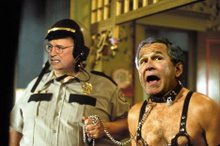More on the Toronto Star's Lucas Oleniuk in New Orleans
Is the Government Trying to Stem the Tide of Images From New Orleans by Threatening Journalists?: Journalists covering New Orleans in the aftermath of hurricane Katrina report that militarization in and around the city has hindered their work and threatened their physical safety. We hear from two journalists who were reporting in New Orleans recently. Video and transcript. This is a must listen http://www.informationclearinghouse.info/article10204.htm [excerpt from the transcript] AMY GOODMAN: That was White House Press Secretary Scott McClellan speaking on Thursday, being questioned by reporters at the White House. Joining us in our D.C. studio is Tim Harper, a reporter with the Toronto Star. He was with his photographer, Lucas Oleniuk, the photographer from the Toronto Star whose photos were taken from him by police. And here with us in New York is Jacquie Soohen. She just flew in last night, an independent filmmaker with Big Noise Films. And we'll talk with her about what happened to her in a minute, but first we go to Tim Harper in Washington. Explain when you were in New Orleans with your photographer and what happened. TIM HARPER: Sure. It was a week ago Thursday. It was a day that things were quite clearly out of control. It was before any federal troops had come in to try to take control of the situation. New Orleans authorities were clearly way over their head at that point, and looting had been breaking out over the past 24 hours everywhere. We drove, Lucas Oleniuk and I drove into the city. We were a couple of blocks away from the Convention Center, when he noticed on the left what looked to be perhaps the start of a shootout. We noticed a New Orleans ETF, emergency task force officer crouching behind his car with his gun drawn. Lucas jumped out of the car. As soon as he did, we heard a quick pop, pop, pop, and gunfire was coming from an apartment block, and being returned by the police. I was told in no uncertain terms at gunpoint to get the hell out of the area, and I complied as best I could. But Lucas was caught essentially in the gunfire because New Orleans police pulled up behind him and started shooting over his shoulder. So during the 15-minute or so standoff that ensued, he was taking pictures alongside New Orleans officers as they were caught in the standoff. Now, subsequently, they did get two suspects out of the apartment block where this incident was happening, and while Lucas was shooting, they administered a rather fierce beating on these two guys. And I guess that was the problem. As soon as they realized that the beating of the suspects was being captured on film, one officer tried to rip the camera off his shoulder. His press tag was ripped off. Eventually, they got one camera and started messing with the camera trying to get the pictures out. Fearful that they were going to ruin his camera, he showed them how to get the images out. His second camera was ripped from his shoulder at that time, and when he asked whether he could get his images back, he was threatened with having his neck broken, had guns pointed at him. I came back to try to help him. I had guns pointed at me. I was told to turn my car around, stop or I'll shoot. I had a shotgun pointed at the windshield. So the bottom line is about 350 images that Lucas Oleniuk took will never be seen, and I thought almost equally as important, ripping off his press tag at that point and leaving him out any press accreditation driving around in the city in that situation made him incredibly vulnerable. It was a very dangerous situation. JUAN GONZALEZ: So, in other words, they did not initially try to stop his shooting of photographs of the shootout. It was only when -- TIM HARPER: Not during the shootout, no. AMY GOODMAN: -- they started to beat the prisoners that they had grabbed that they became concerned? TIM HARPER: Yeah. No, it's not clear at that point whether they allowed him to keep taking the pictures, because obviously, they were worried about sniper fire coming from the apartment, and they didn't want to do anything to endanger themselves. But there was -- nobody tried to intervene. He actually at one point ran across the street from -- he had taken shelter behind a light standard, and then while the shooting was going on, ran across about a quarter block length to get behind a cruiser for better protection, beside another officer shooting, so, no, there was no move to stop him from taking pictures while they were involved in the shootout. AMY GOODMAN: Tim Harper is a reporter with the Toronto Star. His photographer, Lucas Oleniuk with the Toronto Star had his film taken. When we come back, we'll also be joined by Jacquie Soohen to talk about her experience as she was filming, as well.

No comments:
Post a Comment